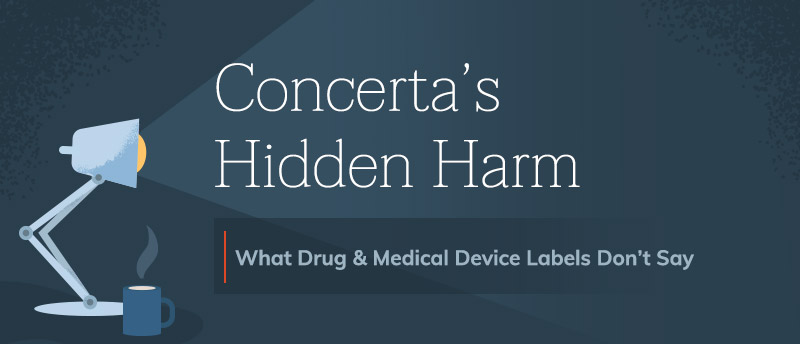A tic is a sudden, repeated, involuntary movement of a body part or vocalization. Common tics include eye blinking, throat clearing, shoulder shrugging, facial grimacing and coughing.
Concerta’s Hidden Harms

Using information compiled during a months-long investigation, we recently launched the interactive Hidden Harms tool on our site. It highlights the risks of several popular drugs and medical devices, showcasing how the current system of drug and device labeling rarely favors the patient.
Last month, we began our Hidden Harms news series with a look at Essure -- an implanted contraceptive device -- and the deceptive labeling and marketing materials that failed to warn patients about the device's serious risks and side effects.
Investigate the Hidden Harms of EssureOur series continues today with Concerta (methylphenidate), an extended-release medication prescribed to treat attention-deficit/hyperactivity disorder (ADHD). Concerta is a unique drug in our series because it is regularly prescribed to children as well as adults.
On Concerta's drug label, Janssen Pharmaceuticals -- a subsidiary of Johnson & Johnson -- clearly acknowledges Concerta is not a safe option for everyone. Like most drugs, Concerta may cause several severe side effects and adverse reactions.
However, it is not easy for patients to learn which side effects could apply to them personally, or their dependents. Potential users have to dig through multiple documents filled with heavy medical jargon and study data to identify all of the potential side effects associated with Concerta.
Today we are breaking down the shortcomings in Concerta's label, including how it fails to adequately warn patients about two major side effects that could affect children taking the drug.
Concerta Label Messaging
The first page of Concerta's drug label prominently notes potential adverse reactions such as abdominal pain, headaches, dizziness, anxiety, and insomnia. However, for a patient or concerned guardian to truly understand the risks and potential side effects that Concerta poses, they would need to read the full 32-page drug label as well as the original drug label from the year 2000.
Only then could a parent or guardian discover the risks of two serious side effects for juvenile patients: new-onset physical tics and anorexia.
New-Onset Tic
It is common for children with ADHD to develop a tic disorder. There is even some controversy over whether or not stimulants like Concerta worsen or induce the development of a physical tic in children with ADHD. Despite conflicting data from several studies, Concerta's current drug label includes information about tic development while using the drug.
In a long-term uncontrolled study involving 432 children, 9% of study patients developed new-onset tics after taking Concerta for 27 months. A second uncontrolled study involving 682 children found only 1% of study patients developed new-onset tics. However, this second study only lasted a third of the duration of the first study.
Concerta's current drug label deters the use of Concerta "in patients with motor tics or with a family history or diagnosis of Tourette's syndrome."
Parents whose child develops a tic while taking Concerta or another ADHD medication should inform the child's doctor immediately.
Anorexia
A common side effect of some ADHD medications is anorexia, or a loss of appetite. When Concerta was first released in the year 2000, clinical trial data showed that 4% of 106 juvenile study patients experienced loss of appetite while taking Concerta over a 4-week period. On Concerta's current label, anorexia is only referenced in adult patients, despite the data from their previous label, as well as data from more recent scientific studies.
In 2014, a study conducted in Iran monitored the adverse drug reactions in 71 child patients taking methylphenidate to treat symptoms of ADHD over the course of 6 months. During that time, 74% of study patients experienced anorexia.
For a child still growing and developing, taking a medication that suppresses one's appetite can be problematic if not dangerous. Janssen Pharmaceuticals currently downplays the possibility of anorexia on its Concerta label, potentially endangering the young patients who rely on the medication.
People have filed lawsuits over Concerta side effects. Learn more >>>
Concerta's Hidden Harms
Concerta is an extremely popular medication for children and adults with ADHD. Although it has the power to help many people take control of their health, it also has significant side effects that can negatively affect a person's quality of life.
It is unrealistic for regulators to expect a child or even a parent to sort through clinical trial data to determine the true risks of the drug.
All side effects should be listed clearly on a drug's label to ensure that Concerta users or their parents can make an informed decision before taking it. Increasing the transparency and accessibility of side effect information will also help ensure patients and their caregivers can identify and respond to serious side effects if and when they occur.
We hope to see more progress towards comprehensible labels for all drugs, including Concerta, in the future. Only when a drug label can be understood by anyone, regardless of a medical degree, will patients be safer from harmful side effects.
Learn more about other drugs and medical devices plagued with indecipherable drug labeling by using our Hidden Harms Risk Explorer.

